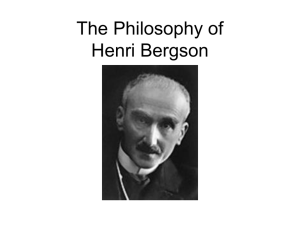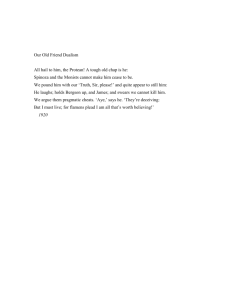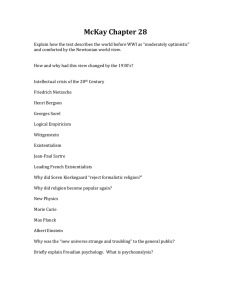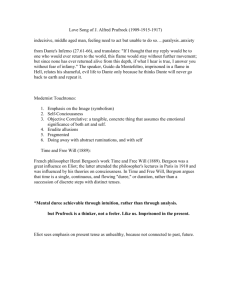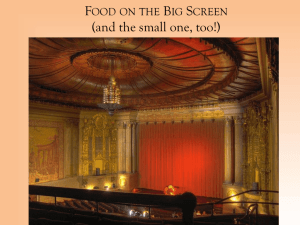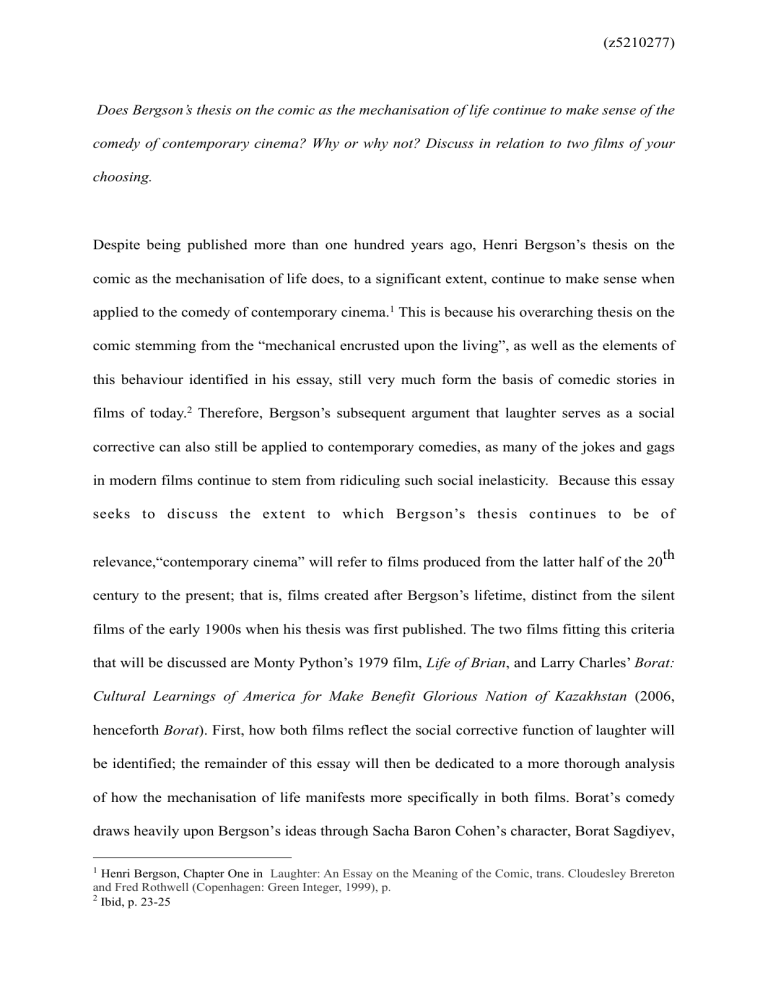
(z5210277) Does Bergson’s thesis on the comic as the mechanisation of life continue to make sense of the comedy of contemporary cinema? Why or why not? Discuss in relation to two films of your choosing. Despite being published more than one hundred years ago, Henri Bergson’s thesis on the comic as the mechanisation of life does, to a significant extent, continue to make sense when applied to the comedy of contemporary cinema.1 This is because his overarching thesis on the comic stemming from the “mechanical encrusted upon the living”, as well as the elements of this behaviour identified in his essay, still very much form the basis of comedic stories in films of today.2 Therefore, Bergson’s subsequent argument that laughter serves as a social corrective can also still be applied to contemporary comedies, as many of the jokes and gags in modern films continue to stem from ridiculing such social inelasticity. Because this essay seeks to discuss the extent to which Bergson’s thesis continues to be of relevance,“contemporary cinema” will refer to films produced from the latter half of the 20th century to the present; that is, films created after Bergson’s lifetime, distinct from the silent films of the early 1900s when his thesis was first published. The two films fitting this criteria that will be discussed are Monty Python’s 1979 film, Life of Brian, and Larry Charles’ Borat: Cultural Learnings of America for Make Benefit Glorious Nation of Kazakhstan (2006, henceforth Borat). First, how both films reflect the social corrective function of laughter will be identified; the remainder of this essay will then be dedicated to a more thorough analysis of how the mechanisation of life manifests more specifically in both films. Borat’s comedy draws heavily upon Bergson’s ideas through Sacha Baron Cohen’s character, Borat Sagdiyev, 1 Henri Bergson, Chapter One in Laughter: An Essay on the Meaning of the Comic, trans. Cloudesley Brereton and Fred Rothwell (Copenhagen: Green Integer, 1999), p. 2 Ibid, p. 23-25 (z5210277) who embodies the mechanical throughout the film as he journeys across the United States.3 The film also highlights the rigidity of the various American communities Borat encounters in an effort to showcase their ignorance4. In a similar vein, Life of Brian’s satire functions by highlighting the mechanical in those who foolishly distance themselves from the rest of the human community and lose their human “spirit” by hiding behind religious sanctity or social class5. Despite being released decades apart, both films are exemplars of the ways in which Bergson’s thesis continues to make sense when applied to contemporary cinema. First and foremost, many contemporary films’ comic elements continue to reflect Bergson’s argument of the function of laughter being a social corrective, as the target of their humour is often groups or individuals deemed eccentric or backwards to the film’s creators and their intended audience. Society, Bergson argues, requires its members to thrive and constantly adapt, and so laughter works to correct mechanical elasticity and eccentricity by provoking in individuals a fear of being the target of it.6 Christian Davies affirms Bergson’s view, arguing that contemporary cinema allows the audience to elevate themselves above the group or individual deemed eccentric or rigid, and “enter and revel in the nasty world of laughter”7. This laughter requires precisely what Bergson identified as an “anaesthesia of the heart”, with the audience distancing themselves from the comic subject to be amused by customs and values seen as inferior to their own.8 In Borat, the two main groups whom laughter is directed towards are Borat and his people, the Kazakhs, and insular American communities.9 As Davies writes, Kazakhs are depicted as “hopelessly primitive and 3 Borat: Cultural Learnings of America for Make Benefit Glorious Nation of Kazakhstan (Larry Charles, 2006) Ibid. 5 Life of Brian (Terry Jones, 1979). 6 Bergson, “Laughter”, p. 23-24 7 Christian Davies, “Borat: Cultural Learnings of America for Make Benefit of Glorious Nation of Kazakhstan: The Ecstasy and the Agony”. Reading: Communication Institute for Online Scholarship, 2008. Accessed 1st July, 2020. http://www.cios.org/www/ejc/EJCPUBLIC/018/2/01849.html 8 Bergson, “Laughter”, p. 11 9 Borat: Cultural Learnings of America for Make Benefit Glorious Nation of Kazakhstan (Larry Charles, 2006) 4 (z5210277) backward,” “bigoted”, and “lacking in all self-control and decency”10. Borat’s departure at the very beginning of the film captures his entire village running after his car on the rundown streets, their collective waving and nonsensical screaming combining with a whimsical score to conjure a sense of collective automatism11. Of course, Borat himself also serves as the main personification of his peoples’ otherness as he becomes the target of many jokes throughout the film.12 Similarly, insular groups in American society are made to look just as foolish, their xenophobia and intolerance highlighted through depictions of their inelasticity as Borat encounters each community13. Life of Brian and its comedy revolves around a very different community set in a time far detached from the present; however, the same function of laughter is very much present. The film’s story concerns a Jewish young man named Brian who finds himself caught between various fanatical religious groups, as well as the Roman Empire, when he is mistaken for the Messiah.14 Steven Benko applies Bergson’s framework to the film’s comedy, arguing that laughter in Life of Brian works as a social corrective against the groups and institutions who cite religion as proof of their superiority above the human community15. Here, the human spirit is an individual’s autonomy and ability to live life according to their own terms despite their mortality; rigidity, then, presents itself as using status, rank, or blind faith to “obscure the flaws and vulnerabilities” that make one human16. Anyone guilty of this kind of behaviour in the film, from Brian’s devout followers to even the Roman governor Pontius Pilate, is quickly subject to ridicule through exaggerating their 10 Christian Davies, “Borat: Cultural Learnings of America for Make Benefit of Glorious Nation of Kazakhstan: The Ecstasy and the Agony”. 11 Borat: Cultural Learnings of America for Make Benefit Glorious Nation of Kazakhstan (Larry Charles, 2006) 12 Ibid. 13 Ibid. 14 Life of Brian (Terry Jones, 1979). 15 Benko, “Ironic Faith in Monty Python’s Life of Brian”, p. 5-6 16 Ibid, p. 4 (z5210277) rigidity in gesture, speech, or absentmindedness17. As will be discussed in more depth below, both films demonstrate how the comic in contemporary cinema continues to act as a social corrective for mechanical inelasticity burdening the human spirit. Whether this inelasticity be general social inflexibility, or an unwillingness to accept the characteristics that make one human, Bergson’s thesis clearly continues to make sense even in modern cinema. A key behaviour connoting the mechanical encrusted upon the living Bergson addresses in his thesis is a certain lack of awareness, and an inability to adapt to social situations18. He argues that the comic arises when mechanical inelasticity takes the place of the pliableness and adaptability inherent in the human spirit.19 Upon analyzing the behaviour of comic characters in contemporary cinema, it becomes obvious that Bergson’s ideas still make sense. As mentioned above, a large majority of jokes in Borat centre around the titular character, Borat Sagdiyev, and his continual inability to adapt to the new social environment around him: American culture and its customs.20 Throughout the film, Borat is thrust into the midst of new contexts that require him to learn the appropriate customs of certain American subcultures or groups before assimilating accordingly, such as an “American humour” class, a Southern dinner party and an interview with feminists.21 Instead of adjusting and learning, however, Borat remains crude, sexually depraved and vulgar, shocking those around him and amusing the audience with his antics. His backwards behaviour, when viewed from the lens of Bergon’s thesis, is highly suggestive of a mechanical rigidity replacing the “wide-awake adaptability and living pliableness of a human being”22. The comic in Life of Brian also comes from a cast of characters who fail to react to arising situations as the audience would 17 Life of Brian (Terry Jones, 1979). Bergson, “Laughter”, p. 14-15 19 Ibid. 20 Borat: Cultural Learnings of America for Make Benefit Glorious Nation of Kazakhstan (Larry Charles, 2006) 21 Ibid. 22 Bergson, “Laughter”, p. 15 18 (z5210277) expect, demonstrating their inelasticity as a result of adhering too closely to propriety. When Brian is caught by a centurion painting the walls of the colosseum with anti-Roman propaganda, one expects him to be punished brutally or even executed for the grave crime of treason; instead, the guard fixates on Brian’s grammatical errors, lecturing him like a schoolchild on verbal conjugation before forcing him to fix his mistakes23. In Bergson’s words, the guard “attends to the petty occupations of his everyday life with mathematical precision”, laser-focused on a simple grammatical error instead of seeing the bigger picture: the serious threat of a civil uprising24. It is only upon the next morning that the guards realise the implications of Brian’s message and give chase25. The disciplined military force which has become emblematic of Roman power has been reduced to a machine that can only continue in a straight line, their highly delayed reaction time inducing laughter at their inelasticity. In a reflection of Bergson’s original thesis, the mechanisation of life through the showcasing of a lack of awareness is prevalent in Borat and Life of Brian, as well as many comedies in contemporary cinema that satirize a failure to embody the adaptability of the human spirit. The subsequent parts of Bergson’s thesis on the mechanisation of life explore how any form, gesture and movement which “reminds us of a mere machine” through rigid repetition combine to create the laughable26. In Part V, he also introduces the notion of garments and uniform being a laughable attempt to disguise the suppleness of the natural living spirit27. Bergson goes even further to assert that ceremony and custom also operates as “clothing” to the social body, with attempts to impose solemnity upon its members becoming 23 Life of Brian (Terry Jones, 1979). Bergson, “Laughter”, p. 14 25 Ibid. 26 Ibid, p. 32 27 Bergson, “Laughter”, p. 39-41 24 (z5210277) laughable when isolated and its behaviours are viewed objectively28. These observations are an accurate description of contemporary comedy, especially satire which focuses on ridiculing broader groups and institutions by stereotyping and minimising their behaviours. When Borat visits a Southern rodeo, donning the cowboy attire appropriate to the event and rousing the crowd with racist, jingoistic calls to violence, one cannot help but see the Americans as machines in their wild costumes and rigid racial bigotry29. Another example is when Borat seeks guidance from the United Pentecostal church near the end of the film30. The attendants of the sermon scream and jump and rave while speaking in tongues, swarming Borat with hands raised; what is ritual to them is, to the detached bystander, comic in its chaotic, nonsensical automatism31. Life of Brian’s mechanisation of those who disguise their human spirit using uniform and custom also aligns perfectly with Bergson’s ideas. One particular scene in the film is dedicated to depicting several soothsayers standing in a row in the streets, each presenting their own interpretations of imminent catastrophes that will befall the world32. One is half-naked and covered in grime, with the others in tattered robes as they shout their outlandish prophecies to passers-by33. The camera drifts between them, capturing their manic screaming and flailing of limbs in a way as to make them look and sound like puppets running on clockwork, all the while cutting to reaction shots of confused civilians which further solidify their dehumanisation34. Of note is the third soothsayer, a dazed old man who seems to act as a generalisation of all of his contemporaries as he proceeds to deliver the vaguest possible predictions35. This is an explicit commentary by Monty Python 28 Ibid., p. 45-46 Borat: Cultural Learnings of America for Make Benefit Glorious Nation of Kazakhstan (Larry Charles, 2006) 30 Ibid. 31 Ibid. 32 Life of Brian (Terry Jones, 1979). 33 Ibid. 34 Ibid. 35 Ibid. 29 (z5210277) on the inherently comic nature of religious heads, with those supposedly in contact with the divine brought back down to earth by highlighting their mechanical characteristics. Another example of this is the film’s portrayal of Pontius Pilate, whose status and pomp is overshadowed by his speech impediment of being unable to pronounce words with the letter “r” correctly36. Pilate’s attempt to maintain an image of regality is thwarted by the centurions’ frequent inability to understand him, and his impediment becomes the target of mockery by his very own subjects37. The Roman governor has been humanised by, as Bergson writes, a “deformity” that a “normally buit person could successfully imitate”, a physical rigidity that is comic in its perpetuity38. Finally, the film’s core gag, Brian’s unwilling assumption of the role of the Messiah, is the ultimate parody of followers of religion39. Brian’s improvised and unintentionally cryptic speech causes him to amass a horde of followers who glorify his every move40. Much like the Pentecostal church-goers in Borat, Brian’s believers repetitively scream of a miracle with their hands raised, their refusal to acknowledge the reality of Brian as an ordinary man obscuring their individual spirits behind the mechanical41. Bergson’s ideas still make sense of the comic in both contemporary films, whose satire undoubtedly revolves around exaggerating the mechanical elements of one’s being to critique their neglect of the suppleness that makes them human. It is clear from the analysis above that Bergson’s thesis on the comic as the mechanisation of life not only continues to make sense in the time of contemporary cinema, but also describes almost perfectly the intention behind, and execution of the comic in many films of today. Bergson’s thesis accounts for the fact that laughter within films is still used as 36 Life of Brian (Terry Jones, 1979). Ibid. 38 Bergson, “Laughter”, p. 26 39 Life of Brian (Terry Jones, 1979). 40 Ibid. 41 Ibid. 37 (z5210277) a social corrective for mechanical inelasticity and eccentricities. Moreover, as demonstrated by Borat and Life of Brian, the characteristics and behaviour identified by Bergson that suggest the mechanical encrusted upon the living still manifests frequently in the comic characters of contemporary cinema. Bibliography Benko, Steven A. “Ironic Faith in Monty Python’s Life of Brian” (2012) Bergson, Henri. Chapter One, “Laughter: An Essay on the Meaning of the Comic” (1911). Translated by Cloudesley Brereton and Fred Rothwell, 7-63. Copenhagen: Green Integer, 1999. Davies, C. “Borat: Cultural Learnings of America for Make Benefit of Glorious Nation of Kazakhstan: The Ecstasy and the Agony”. Reading: Communication Institute for Online Scholarship, 2008. Accessed 1st July, 2020. http://www.cios.org/www/ejc/EJCPUBLIC/ 018/2/01849.html Filmography Charles, L. Borat: Cultural Learnings of America for Make Benefit Glorious Nation of Kazakhstan, 2006. Jones, T. Monty Python's Life of Brian, 1979.
